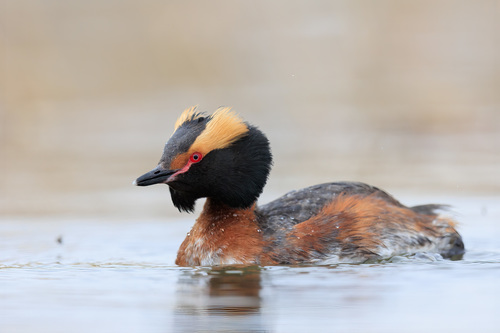
Horned Grebe
The Horned Grebe (*Podiceps auritus*) is a small, strikingly beautiful waterbird known for its elaborate breeding plumage, featuring golden "horns" and a rich, chestnut-red neck. This species plays a vital role in freshwater ecosystems, primarily as a predator of small fish and aquatic invertebrates. It is a relatively widespread species, though populations have experienced declines in some areas, making it a species of conservation concern. Culturally, the Horned Grebe is sometimes admired for its elaborate courtship displays, which are among the most complex in the grebe family.
31-38 cm
Length
46-55 cm
Wingspan
Vulnerable
Conservation Status
Distribution
The Horned Grebe has a Holarctic distribution, breeding across North America (Alaska, Canada, and the northern United States) and Eurasia (northern Europe and Asia). It migrates south for the winter, inhabiting coastal waters and ice-free inland lakes.
Lifespan
Approximately 5-10 years in the wild.
Horned Grebe's Habitat
Habitat Types
Freshwater lakes, Ponds, Marshes, Coastal bays (during winter)
Climate Zones
Temperate, Boreal, Subarctic
Adaptations
Horned Grebes have lobed toes, which are excellent for swimming and diving. Their legs are positioned far back on their bodies, providing efficient underwater propulsion but making them awkward on land. They also have dense, waterproof plumage.
Variations
Two subspecies are generally recognized: *P. a. auritus* in Eurasia and *P. a. cornutus* in North America. The North American subspecies is slightly larger.
Appearance
Breeding Plumage
Breeding plumage includes a black head with prominent golden-yellow "horns" (actually tufts of feathers), a chestnut-red neck, and black back. Non-breeding plumage is much duller, with a grayish-black back, white cheeks, and a white neck.
Seasonal Feather Changes
The dramatic change between breeding and non-breeding plumage occurs during molting periods in spring and fall.
Sex Based Plumage Differences
Males and females have similar plumage, though males may have slightly brighter breeding colors.
Notable Features
Golden "horns" (breeding plumage), Red eyes, Lobed toes, Sharp, pointed bill
Diet and Feeding
Primary Foods
Small fish, Aquatic insects, Crustaceans, Mollusks
Foraging Behavior
Horned Grebes are pursuit divers, diving underwater to chase prey. They use their feet for propulsion and their wings for steering. They may also forage near the surface, picking insects from vegetation.
Specializations
Their sharp, pointed bill is well-suited for catching and holding slippery prey.
Seasonal Diet Variations
During the breeding season, insects and crustaceans may form a larger part of the diet, while fish become more important in winter.
Behavior
Social Structure
Generally solitary or in pairs during the breeding season; may form small flocks during migration and winter.
Communication
Variety of calls, including trills, whinnies, and chattering sounds, Visual displays, such as head shaking and synchronized swimming
Migration
Migratory, moving from breeding grounds to coastal areas or ice-free inland waters for the winter. Migration is often nocturnal.
Territorial or Group Behaviors
Highly territorial during the breeding season, defending nesting areas aggressively against intruders.
Conservation
Threats
Habitat loss and degradation (wetland drainage), Pollution (pesticides, oil spills), Climate change (altered precipitation patterns, lake drying), Disturbance from human activities (boating, fishing), Entanglement in fishing gear
Protection Programs
Wetland conservation and restoration efforts, Monitoring programs to track population trends, Legal protection under migratory bird treaties (e.g., Migratory Bird Treaty Act in North America)
Local National Laws
Protected under various national and international laws, including the Migratory Bird Treaty Act in the United States and Canada.
Population Trend
Decreasing
Population Estimates
Global population estimated at 200,000 - 530,000 individuals.
Interesting Facts
Horned Grebes swallow feathers
This behavior is thought to help protect their stomach lining from sharp fish bones and to aid in forming pellets of indigestible material that they regurgitate.
They can adjust their buoyancy
By controlling the amount of air trapped in their feathers and air sacs, they can float high on the water or submerge completely.
Chicks sometimes eat feathers fed to them by their parents.
This helps establish the feather-lining in the chick's stomach early in life.
Faqs about Horned Grebe
Where can I see a Horned Grebe?
Look for them on freshwater lakes and ponds during the breeding season, or along coastlines and ice-free lakes in winter. Check local birdwatching guides for specific locations.
Are Horned Grebes related to ducks?
No, grebes are in a separate order (Podicipediformes) from ducks (Anseriformes). They are more closely related to flamingos.
Why are they called "Horned" Grebes?
The name refers to the prominent golden-yellow feather tufts on their heads during the breeding season, which resemble horns.
Do both the male and female have "horns"?
Yes, both sexes develop the "horns" during the breeding season, although they may be slightly more prominent in males.
Copyright @ Nature Style Limited. All Rights Reserved.
 English
English